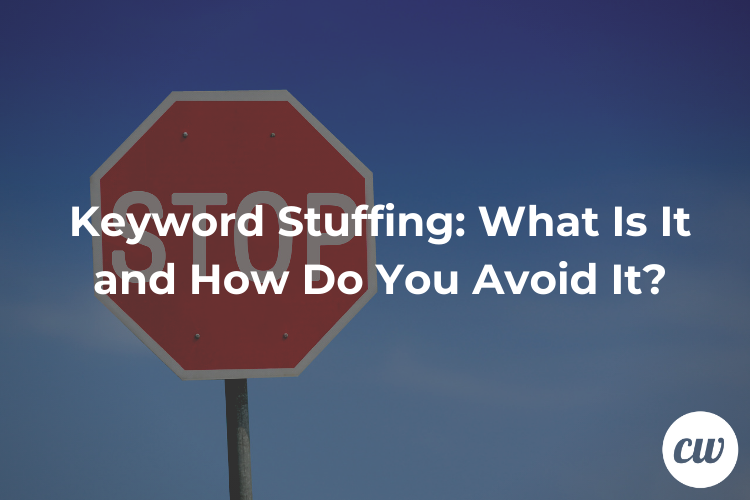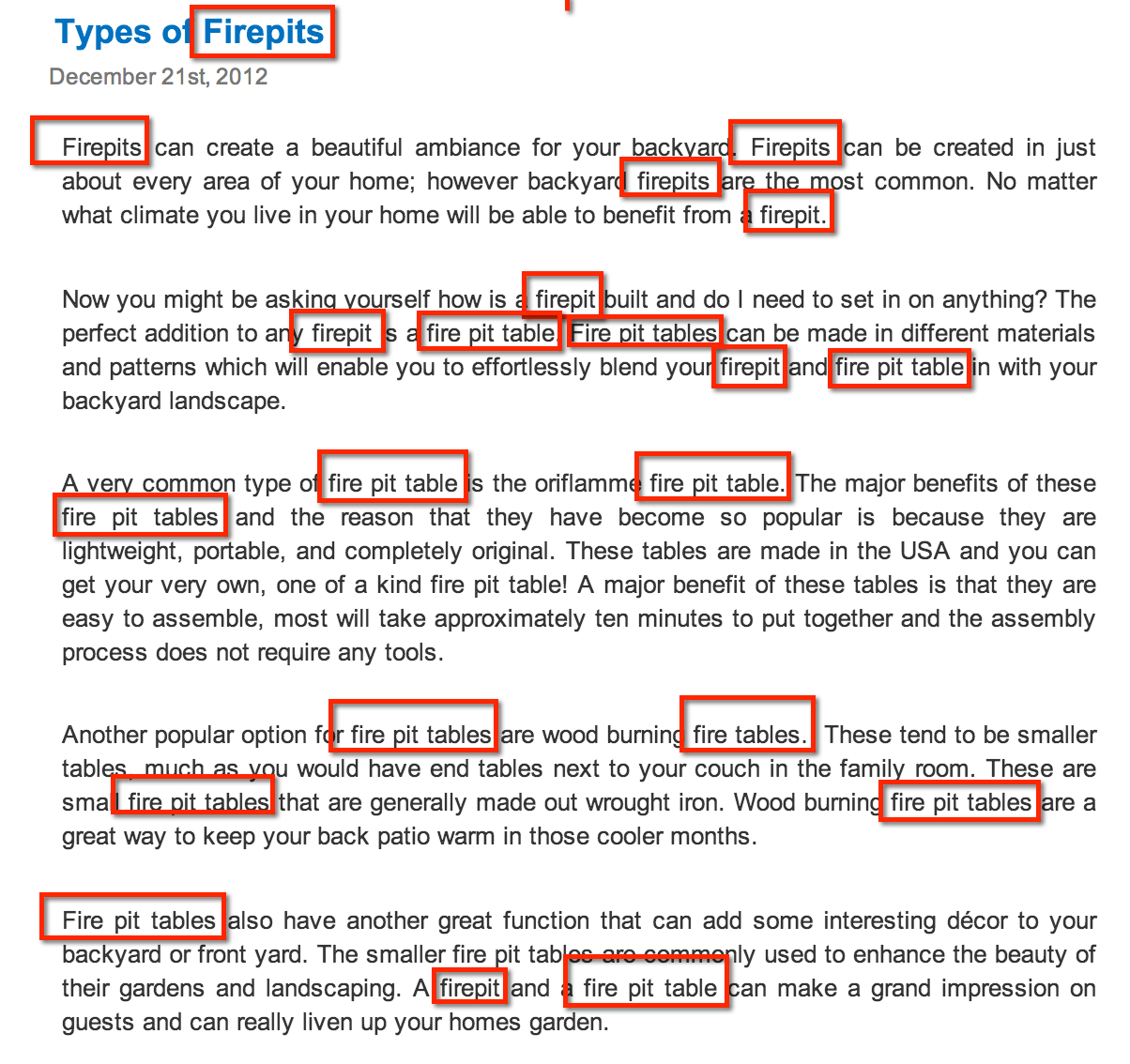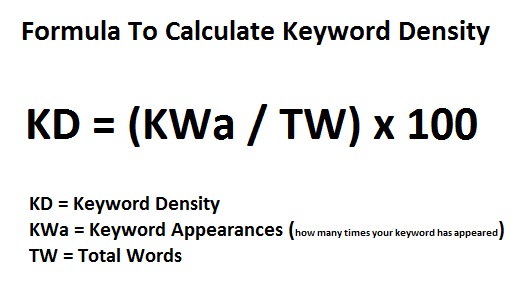
Keyword Stuffing: What Is It and How Do You Avoid It?
Many content creators have resorted to keyword stuffing at one time or another, so you’re not alone.
It’s also a big SEO no-no often found on “things not to do” lists.
But it’s hardly a new concept. It’s been around pretty much since the early days of publicly accessible Internet in the mid-1990s. Yet, keyword stuffing is still very much alive and well in 2020.
To be fair, it sometimes happens totally by accident. Other times, however, going way overboard on keyword density is intentional. Either way, Google doesn’t like it, and your target audience may not be too happy about it either.
The best way to deal with this common and persistent SEO problem is to dive into the world of keyword stuffing. Continue reading and you’ll also discover steps you can take to avoid it.
What Exactly Is Keyword Stuffing Anyway?

Google officially defines keyword stuffing as the practice of loading webpages with numerous keywords in an attempt to manipulate a website’s ranking on search engine results pages (SERPs).
Google points out that such terms, which they also refer to as “irrelevant keywords,” often appear in groups, lists, or out of context. It’s this last thing that can be especially annoying to your intended audience.
For example, there might be a need to twist sentences around or phrase things awkwardly and out of logical order just to fit more keywords into content — e.g., “repair roof Brooklyn.”
All this does is break the reader’s concentration and interrupt the flow of content. And once a reader’s attention is diverted, it’s not easy to get them back.
HubSpot refers to keyword stuffing as a black hat SEO technique since it’s often done for the purpose of search engine manipulation. They also call it a “practice against search engine guidelines,” which it essentially is — whether it’s intentional or not.
Google never comes out and says, “No keyword stuffing or you’ll be in big trouble, mister!” Well, at least they don’t exactly phrase it that way. But it’s absolutely possible to get penalized for manipulative SEO tactics of this nature.
Let’s assume you honestly aren’t intentionally peppering your content with keywords with a Dr. Evil grin as you hope search engines won’t notice. So, how can you tell whether you still might be overdoing your keyword density per page? Look for these signs:
- Content that’s not reading naturally
- A keyword ratio per page that’s clearly way too high
- A lack of complementary keywords or synonyms
- Traffic that’s not growing
The last one on this list can happen for two reasons. First, you may have received a penalty for keyword manipulation without actually knowing it (especially if you’re not diligent about checking your Google Search Console stats). Second, your intended audience may simply be turned off by your content and the way keywords are affecting readability.
Keyword stuffing can be further categorized as visible and invisible. The visible kind is what any visitor to a website can see. The invisible kind is done solely to trick search engine crawlers. Both of these things are technically bad, but the second one is worse.
Visible Keyword Stuffing
In some instances, visible keyword stuffing is unintentional. For example, a kitchen appliance store might use the keyword “appliances” too often without being aware they are doing it.
But if that same appliance store puts the words “affordable kitchen appliances” in every single paragraph and again at the end, this is likely intentional keyword stuffing.
There’s an equation that can be useful when determining if keyword density is an issue. Guidelines vary somewhat, but generally it’s best to shoot for a KW density of 2-3 percent or less.
Specifically, keyword density is defined as the number of times keywords appear in content divided by the total number of words in that content.
Even visible overuse of SEO keywords can be done in ways that are less obvious in an attempt to be manipulative. Some sites do this by dumping extra keywords in footers or by creating irrelevant keyword lists.
Invisible Keyword Stuffing
In an attempt not to alienate or annoy readers, some sites stuff their keywords where they’re not seen by website visitors. This is sometimes done by:
- “Hiding” text with excessive keywords by making it the same color as the webpage’s background color
- Inserting keyword-loaded text in the page’s code
- Using extra keywords in meta, comment, or alt tags
Attempting to fool algorithms this way is riskier today since search engines are much better at finding instances of keyword abuse. Now, let’s talk about what you can do to avoid using your main SEO keywords in a way that comes across as keyword stuffing.
Make Synonyms Your Friend
A simple way to avoid issues with keyword optimization gone wrong is to replace excessively repeated keywords with synonyms. There are plenty of synonym tools that can be used to generate a list of similar-meaning words.
But still keep the intended audience in mind when doing the synonym thing. You’re not going to do yourself any favors by using obscure synonyms that instantly confuse readers.
Use Your Keyword Research Results
Another way to avoid stuffing keywords into your content is to use the results you get from your keyword research. Common keyword research tools can also generate lists of relevant keywords for you.
You’ll then be able to search through the lists for related SEO keywords. By doing this, you’ll be able to swap related keywords around enough to minimize the need to repeat the same ones too many times. However, you’ll still be getting sufficient SEO leverage.
Use Long-Tail Keywords
If you’re already using long-tail keywords, you’re on the right track. If you’re not, this could be one of the reasons for your keyword stuffing issues.
As for what long-tail keywords are, they are basically longer and more specific keyword phrases related to products or services or a specific brand or type of business. They are typically used to attract the attention of searchers just about ready to make a purchase.
Once you’ve selected some long-tail keywords, search for your preferred phrases or keyword groupings on Google’s Keyword Planner. You’ll be able to further filter your long-tail selections by the number of words used in the phrase.
You’ll also be able to pick long-tail selections with low competition and a high search volume. This helps minimize instances of keyword stuffing since you are less likely to feel the need to repeat long-tail keywords as much as single keywords.
Write Longer Content
The recommended content length has been steadily increasing. There’s no general consensus on just what the “perfect” length is, but longer is better these days when it comes to inspiring engagement and content sharing.
It’s also a smart way to reduce keyword stuffing issues. If content is longer and more in-depth, it’s much easier to naturally spread out keywords and minimize the need to repeat your main SEO keywords.
If you’re curious about just what the recommended length for content is today, Search Engine Journal conducted a survey via Twitter in an attempt to answer this question.
Just over 30 percent of respondents simply said “it depends.” Nearly a quarter of the survey takers said a thousand words or less was sufficient. Others said 2,000-plus words is best for ranking purposes with more in-depth content.
Use LSI Keywords
Latent semantic indexing (LSI) keywords are keywords naturally related to a topic. Using them will let search engines know that the keywords you are using are related to your content’s main topic.
This is helpful because it can be really difficult to avoid a higher keyword density when discussing certain topics. But if you give search engine crawlers a clue about why you are doing this, you may have fewer issues with keyword stuffing.
What’s more, if LSI keywords are used properly, Google and other leading search engines will see them as being semantically-related to a topic. Of course, it’s still best to try and vary usage as much as possible.
Avoid Obvious/Overused Keywords
If you know you’ll likely overuse a keyword in your content, either choose variations or just don’t use it. Instead, do your research and find other search terms that could direct people to your content.
For instance, with an article on SEO basics, “SEO” will likely be used a bit too much. So, opt for keywords like “Florida search engine optimization” or “Miami SEO” to avoid going for the obvious.
This is also a great way to localize your content, so you’re getting more than one benefit with this tactic. If you’re really stuck for related SEO keywords, tools like Answer the Public can be helpful.
Another way to achieve the same goal is to simply enter the name of your topic, product, service, or business into Google’s search box. As you type, see what suggestions come up.
If you start to type “pizza,” for example, you’ll get “pizza near me,” “pizza places near me,” and similar terms. Since these results are based on real-time search results, you’ll get a better idea of what keyword alternatives can still be effective so you can stick to an acceptable keyword density.
Write for Real People First
Another way to avoid keyword stuffing is to write content with real people in mind first. After you do this, go back and check your keyword usage.
If you find it’s too difficult to work in some of the keywords you already researched into the content, consider nixing the awkward or odd-fitting ones.
Watch Your Keyword Usage in Less Obvious Places, Too
Your main keywords should also appear in things like meta titles and descriptions. URLs can also have keywords, and so can image descriptions and subheaders.
Meta descriptions, in particular, can be stuffed with too many keywords. A good rule of thumb is to limit keywords in these short descriptions to your main SEO keyword.
Check Competitor Keyword Densities
Correct SEO keyword usage is all about finding that “sweet spot” with keyword density. Another approach to take to achieve this goal is to look at what your competition is doing keyword-wise.
This will give you a better idea of what that happy medium is between keyword usage and what produces meaningful results. Here’s a full list of tools you can use to find out more about your competitors’ keywords.

Unique Keyword Density Challenges for Content Writers
Content writers don’t always have control over keyword selection. Oftentimes, clients will tell outsourced writers what keywords they want and how many times they must be used.
There’s nothing wrong with this, per se. Still, it can present some challenges when keyword density is WAY too high because of usage requirements.
With situations like this, content writers with no say in keyword density have two options:
- Explain keyword stuffing to the client: This is kind of hit or miss, but if done with enough tact and clarity, it’s sometimes effective.
- Get creative with keywords: Yes, this sometimes means struggling with ways to make awkward phases sound natural, but it’s sometimes an achievable goal.
One other option is to offer acceptable keyword variations to clients. This way they’ll still get to emphasize what they want search engines to pay attention to without having keyword stuffing issues.
Have a Keyword Density Plan
Lastly, further minimize the need to overdo it with keywords by having a solid, healthy keyword density plan to work with. Such a plan can be broken down into six steps:
- Assign a primary keyword per page, but also use acceptable variations of that keyword.
- Shoot for more than 300 words with informative content.
- Determine the appropriate keyword density per page and double-check to make sure you aren’t going over it.
- Add synonyms, secondary keywords, and long-tail keywords into the copy.
- Place your keywords in the right page elements.
- Check your stats when everything is posted to see if your keyword density is on the mark based on the results you are seeing.
Final Thoughts
The best way to avoid keyword stuffing is to be smart about keyword optimization. The right approach to keyword research is equally important.
Ultimately, what matters most is awesome, audience-focused content. Follow this rule of thumb and you should be fine with keywords: real people first, search engines second.
Ken is a freelance writer currently living in the Pittsburgh area of Pennsylvania. Born in California, his fondness for writing dates back to elementary school writing contests and led to positions on both high school and college newspapers. He earned a degree in Journalism and Communications from Point Park University and did work in data entry after college before transitioning to a full-time career as a freelance writer. While his areas of expertise are marketing and health-related content, Ken is a versatile writer and enjoys exploring and researching a variety of topics. When not busy knocking out articles, he likes to spend time with friends, go for walks, and discover new and exciting things about the world around him.







